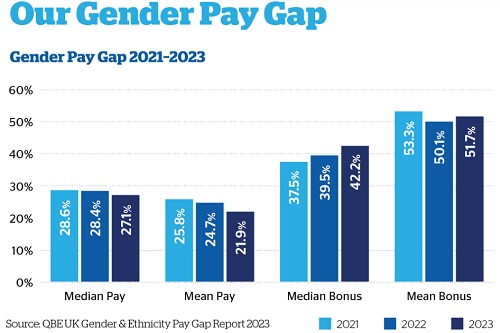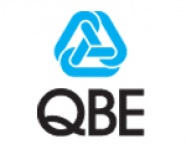How QBE is closing the gender pay gap

Authored by QBE People Director, Culture & Employee Experience Nikki Lees
QBE celebrates the first year of equalised parental policies for employees, as research reports that flexible working and increased paternity leave is key to closing the gender pay gap
It’s a big question – and one that sometimes feels frustrating to be taking into 2024. But at the end of last year, an article in the Guardian indicated that, “UK women aged 40 and older will not experience the closure of the gender pay gap until after they reach state pension age.” There’s clearly still a way to go.
Since companies in the UK started reporting on their gender pay gaps annually in 2017-18, the results have driven the question of gender equality to the top of business conversation – particularly in the insurance industry and broader financial services sectors, where the gap is still slow to close.
Helpfully, mandatory pay gap disclosure has been an effective motivation for more leaders to speak about the gender pay gap, and in the financial services sector reporting seems to be driving a positive shift in corporate culture.
Examining the gender pay gap for the purpose of self-reporting tends to lead to an increased awareness of the root causes of inequity, whether that’s broadly, across different market sectors – or within individual companies.
In 2023 Priya Sahni-Nicholas, of the Equality Trust, urged leaders to:
“[…] prioritise tackling the systems and structures within our economy that perpetuate pay gaps – such as […] reform of parental leave entitlement and a work culture built around flexibility – alongside mandatory action plans to close the persistent pay gaps we see across gender, ethnicity and disability”.
Typically, corporate organisations will have seen a correlation between the gender pay gap and the number of female employees taking maternity leave and/or taking up senior positions. As companies pay closer attention for reporting, more connections emerge – including shifts relating to flexible working policies and inclusive environments.
Alongside improved systems and structures, the cultural shift of increased awareness should drive an uplift in proactive agendas on diversity, equality, and inclusion. Additionally, gender pay reports are starting to factor into recruitment strategies, as millennial and Gen Z candidates consider results as a measure of company values.
At QBE, we want to evolve to embody a more diverse and inclusive workforce. Focusing on key structures and systems is an important step to closing the gap on gender and ethnicity pay and bonuses.
QBE’s gender pay gap
In examining our own progress at QBE, we’re pleased to have seen another reduction in both our median and mean pay gap (-1.3% and -2.8% respectively).
This year saw a larger decrease compared to 2022 and marks our biggest mean gap closing since we started reporting in 2018.
There is work for QBE to do to achieve parity and as we move into 2024, we will continue address our bonus pay gap, which has seen an increase for both mean and median since the last report (+1.6% and +2.7% respectively). This is the first time our mean bonus gap has seen an increase in the last three years.
Higher bonus pay-outs to new senior male hires versus female hires on average has contributed towards the increasing gap, alongside a significantly higher number of women in part time positions, affecting the overall bonus gap. Bonus eligibility (based on joining dates) also impacted the reported data.
Nonetheless, we are still also committed to drive change in line with our Women in Leadership Action Plan, with activities including utilising feedback from our ‘Women in Leadership’ focus groups, building out external partnerships, and upskilling QBE leaders to better support colleagues in their career journeys.
Systems & structures: equalised parental leave narrows the pay gap
Actions speak louder than words (especially corporate pledges) – and one of the key policies that we believe will help narrow the pay gap at QBE, is equalised parental leave.
In 2023, the campaign group Pregnant Then Screwed, the Centre for Progressive Policy (CPP), and Women in Data shared research that showed increasing entitlement to paternity leave and pay could help close the gender pay gap and increase UK economic output by up to £23 billion.
They also reported on a 4% decrease in gender wage gap and 3.7% smaller labour force participation gap in countries with more than six weeks of paid paternity leave.
As the UK currently allows for the least generous paternity leave policy in Europe – two weeks paid at a set rate of £172 a week, just 44% of the national living wage – it’s really important for us to dig into the data, recognise the correlation between parental leave and the gender pay gap, and support working dads here in the UK.
At QBE, we understand that breaking down gender stereotypes and challenging the norms around who raises children in the home is a key piece of the puzzle. We’re prioritising the removal of barriers to career progression by challenging traditional gender roles both at home and at work – and we are confident that this will reflect positively in a narrowed gender pay gap and increased equity in leadership.
Employee benefits: what does QBE offer in parental policies?
We modernised our approach to paternity leave at the beginning of 2023 to mirror other parenting policies and enable partners and co-parents to take up to 52 weeks of leave, with 26 weeks at full pay.
Regardless of gender, sexual orientation or how you become a parent, our employees are entitled to the same leave and support.
We reach out to all expectant fathers and their managers on a one-to-one basis to explain the enhancements and encourage leaders to celebrate and normalise fathers taking extended leave. Managers support their wider teams to manage the impact through adaptations to roles, revised workloads, and redistribution of work to enable parents to take this leave.
2023: a successful first year
Over the first year of QBE’s equalised parental leave policy, 56 fathers have taken up parental leave with 73% of those taking the 26 weeks/6 months of full pay.
An additional five men have taken over six months of parental leave, benefitting from extra time at home with their child beyond the paid allowance.
Our enhanced paternity leave policy has been incredibly well received by employees and prospective candidates in 2023, which shows in the sharp increase in take up. The average length of paternity leave taken at QBE has changed from 8.6 days in 2022 to 150 days in 2023 (for enhanced leave).
Simon Pearce, Programme Manager, has been one of QBE’s first employees to benefit from the enhanced parental leave policy. He said, “It is hard to articulate fully the importance I place on spending time with my children and supporting my wife as our family grows. Time I will never see again, shared in a way that was not possible when I started my career.
“My employer knows that by giving me the chance to be a good dad to my children and husband to my wife I will be a productive employee to them. I don’t think I could have the work/life balance that I have now with any other company in my industry, and I will be forever grateful for this time, focused as much on parenting as career progression.”
Future focused: is this the new normal?
QBE is delighted with the positive impact equalised parental leave is already having on our people – and we hope our first year can serve as a model, demonstrating that progressive “structures and systems” and internal policy change can effectively support workplace equality.
We recommend understanding not only your marketplace but thinking beyond your industry to look at what other organisations are doing in this space. Companies do not need to engage with an expensive third party to do a full benchmarking exercise – there is a lot of information available from other organisations on the policies they are trialling and implementing.
Small businesses face a different set of challenges, but employers may consider enhancing parental leave policies by just one week, before working towards enhancing by another week the following year. Any change in the number of weeks offered can make a difference to families.
Lastly, we really valued listening to our people and acting on their feedback. Working alongside the recruitment team will also help employers understand what candidates are looking for, differentiating your organisation to stand out and attract top talent.
Upon hearing about our extended paternity leave policy during recruitment, one candidate said:
“[This is] very impressive, I am looking for longevity in my next career move so it is great to know that I can join a company that already has the benefits in place to support me when I am ready to start a family”.
About QBE
QBE European Operations is part of QBE Insurance Group, one of the world’s leading international insurers and reinsurers and Standard & Poor’s A+ rated. Listed on the Australian Securities Exchange, QBE’s gross written premium for the year ended 31 December 2018 was US$13.7 billion.
As a business insurance specialist, QBE European Operations offers a range of insurance products from the standard suite of property, casualty and motor to the specialist financial lines, marine and energy. All are tailored to the individual needs of our small, medium and large client base.
We understand the crucial role that effective risk management plays in all organisations and work hard to understand our clients’ businesses so that we offer insurance solutions that meet their needs – from complex programmes to simpler e-trading solutions – and support them in minimising their risk exposures. Our expert risk management and rehabilitation practitioners focus on helping clients improve their risk management so that they may benefit from a reduction in claims frequency and costs.


